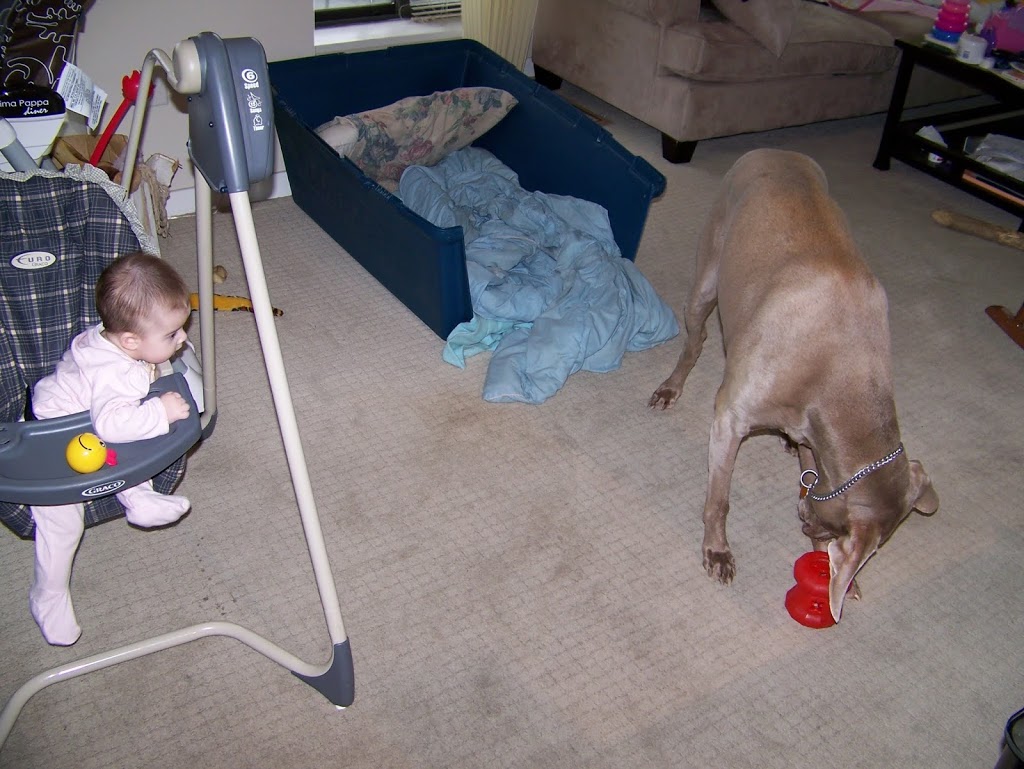
So your children like dogs. They know someone who has a dog at school. They want a dog they bug you endlessly to get one. Maybe you had one at their age. You think it’s a good idea. But you worry about the cost of dog ownership, the responsibility and if the work is worth the value to your child. What else will dog owning do during childhood development to make ALL THIS WORTH IT!
Family Dogs Have Intrinsic Value for Children
I have owned a dog before on my own and during our family’s early years of childhood. I started this blog as my dog aged. There were so many questions I had about senior dogs as I progressed through that journey. Along the way our dog Titan was joined by our daughter, Caroline, who was born in the summer of 2011.
I kept writing about dogs while on maternity leave, but I quickly took on a new interest; family dogs and childhood development. It was easy to see that after 3 months in our world, infants can already show interest in their family pets. Parents get first hand observations of a unique bonding between infants, toddlers or children and the family dog.
So when we talk about the value of owning a dog while your children grow and become teenagers, realize there is so much more to the decision that is backed by academic, peer reviewed research that has an overwhelmingly positive outcome for children’s development.
Benefits of Growing Up with a Family Dog
I reviewed multiple academic peer reviewed journals regarding family dogs and children’s psychosocial development. Initially, many of the parents in the research studies had average concerns regarding getting a family dog. As we all do, the parents worried most about the amount of time the family had to provide adequate pet care and they were also concerned regarding the cost of dog ownership as it is a long-term commitment (Carlisle, G.K. 2013).
In my house as we look forward to one day getting another dog for ourselves, our primary concern is having more than an apartment. So the dog will have access to the outdoors, and adequate space indoors. It’s a tight fit for us at the moment.
What are some of your concerns when you consider getting a family dog? Some families do not plan much at all. It is a unanimous decision and they are prepared to take each challenge as it presents itself.
How Dogs Actually Benefit Children’s Development
A study done by A.M. Gadomski et al. (2015) found that children who had a dog at home had reduced stress and anxiety compared to rates of stress and anxiety in children who had no pets at home.
coincidence versus truth
The researchers, Gadomski et al (2015) do raise the point that it is hard to determine whether having a family dog is actually the reason children experienced less stress and anxiety or whether more laid back children generally where more likely to have family dogs? This is what I find so exciting and fun about research! By trying to answer some questions more questions arise!

Research proves dogs facilitate social development in Children
Gadomski et al (2015) stated that dogs do promote children’s physical and mental health in an overlapping, complex interplay of social norms. They developed a model outlining play, caretaking, social interaction and companionship being the core social norms promoted by dog ownership within the family.
What do you think about this model?
Why is this developmental Research so important?
Research is so important to childhood development because a study initially conducted in the 1990’s, The Adverse Childhood Experience (ACE Study), showed a direct correlation between long-standing, chronic exposure to life stressors in childhood and cortisol release correlates to health and longevity in adulthood. More simply put, constantly highly stressed and anxious children experienced stress hormone release that negatively impacts their adult health. Constant long-term cortisol, or stress hormone release, has been correlated to damaging the heart, lungs and mind overtime. Children who grew up with constant fluctuations and stress in childhood where much more likely to development poor health habits and smoke, drink alcohol or take drugs than children with less stress and more stability.
Do you have to have a family dog to maximize your children’s development? No, this is just to illustrate that among many factors that parents can control, owning a family dog, if they chose too, provides the child with a secure, non-judgemental companion which gives all children a chance to debrief and reflect on life events. A dog is another outlet that helps build resilience in children. Resilience is achieved when the child develops coping skills that preserve their self-esteem, emotions and sense-of-control.
Tips For Parents: Building Resilience in Your Children without a dog
So you don’t have a dog, or maybe you do, but you want to know how you can help your child be resilient. Here’s some tips as parents on how you can promote your child’s resilience.
- Validate your child’s emotions. What’s important is not necessarily that you always agree but that you say something assertive like “I understand you feel (insert kid’s emotion here) but the reason is still no because (give rationale)”. Rationales regarding safety issues are especially powerful. Example “I know you want to play with the cord because it seems fun, but I won’t let you play with electricity because it is dangerous and I don’t want you to get hurt”.
- Tell your child you are proud of them. Think of your child’s strengths. Find the things that are unique to them. Tell them “I’m so proud of your (drawing, manners, sharing)” and try to elaborate on your first comment “I see you coloured the rainbow really beautifully”. If your child explains the drawing – you have succeeded! Show interest, ask your child questions about their drawings, work, or qualities and behaviours that impress you. “When you shared that toy with your sister, it made her so happy! She knows it is very important to you, imagine how important it makes her feel that you trust her so much?!”
- Age-appropriate responsibility. Give your children tasks around the house that are within their skill set and safety. Age 3 years and older might set the table for meals, 6 years and older might vacuum for a few minutes with assistance to plug in the vacuum and direct parental supervision. Giving your child age-appropriate responsibility enforces their sense of community, makes them accountable, and shows them that their actions have a positive benefit to others.
- Have adult discussions at a child’s level. Discuss current world events around your children. When your child asks questions about the conversations give them answers in a simplified why that they can understand. Let your child’s questions guide what they are ready for. Only answer what your child wants to know. Giving too much information, before they can process it will be lost on them. Children need lots of processing time. If they come back in a day or two with another question or a comment on a previous discussion, yes, that’s how long they have been processing the information for!
Especially now with the Coronavirus trending in the media, your children may have questions and concerns. Even as adults if we are feeling stressed and anxious about the future health of our loved ones and even our finances, a discussion with your child may highlight what you are doing to help protect them and what changes are happening in the local community to keep them safe as well. Keep a positive focus. It is reassuring that very early studies on the Coronavirus show that children have less severity of symptoms and have been managed well at home. It is thought that this is due to child’s immature immune system and their unique ability to be like a “carrier” of the virus, without symptoms but still able to transmit the illness to others.
British Columbia’s Children’s Hospital states children 10 years and under seem less like to get Coronavirus as severe as adults and they link a hand washing post to their article (2020), however, other sources like Toronto Sick Kids Hospital is not laid back about the pandemic and is advising when to come to hospital and provides a list of symptoms to monitor your child for.
These different ideas generate discussion and show that the world is large with many people having many different ideas. Discussing current events with your children gives your child insight into the rest of the world, makes them reflect on how other’s experiences vary from their own, and helps them gain resilience skills through other’s stories rather than direct exposure.
- Set an example: “Please” and “Thank You”. As a parent, try incorporate “please” and “thank you” in your daily interactions with your child and even with your spouse. Showing respect to eachother goes a long way! Watch and you’ll see results for role modelling polite manners! Think of these phrases for example: a parent says to the child “PICK UP THAT PENCIL NOW!” or “could you please pick up that pencil?” which way would you talk to your best friend? How would you talk to your boss? How would you talk to your spouse? So, how can you speak to your child?
Safe Adults and Dogs Help Keep Children Safe
Children naturally try to do the right thing and are willing to please. They are direct products of their environments. They are generally sensitive and reflective of their surroundings and the people closest to them have the greatest influences. The larger a social network of safe, protective, and caring adults a child has the more the child grows in a positive, safe, environment and can explore the world with confidence.
Conclusion
In this informative post we looked at the investment value of getting a family dog when you have children at home. First, we briefly review more typical decisions parents are concerned about and then we look at what research found when exploring how children grow and develop when they have a family dog.
We review the ACE study because it holds such value in how vulnerable children are. That the child’s idea of perceived stress and trauma largely impacts their life-long development in regards not only to their psychological but also medical health. Some ACE factors are controllable and many are not. There are many ways to bring positive influences and relationships to children, one of which is through pets.
The ACE study has such an impact world wide that maternity leaves are increasing to 18 months in some countries and areas of Europe are continuing to explore how to maximize positive family and early childhood experiences, including social benefits. There is even thoughts of developing a “teenager leave” in some countries so that parents can be more available for the child in the second and third biggest phase of their development.
Having a family dog promotes your child’s health by buffering anxiety and stress, promoting social interactions, getting children outside to play, and providing first hand experience in caring for and caring about someone else, therefore expanding their development of empathy and emotional intelligence.
References
Carlisle, G.K. (2014). Pet ownership decisions for parents of children with autism spectrum disorder. Journal of Pediatric Nursing. 29(2) pp. 114-123.
Gadomski, A.M., Scribani, M.B., Kupra, N., Jenkins, P., Nagykaldi, Z., & Olson, A.L.(2015). Preventing chronic disease: Public health research, practice and policy. 12 E206.


